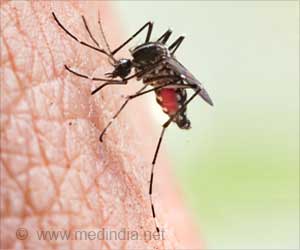Wet weather in some parts of the US and Canada heralds the menace of mosquitoes. The month long heavy rains have sent floodwaters rushing through large areas.
Wet weather in some parts of the US and Canada heralds the menace of mosquitoes. The month long heavy rains have sent floodwaters rushing through large areas in both the countries . It has also left puddles of standing water all over the place, leading health officials to warn against the dangers of disease-carrying mosquitoes.
"When we have more rain like this, our mosquito population can go up, and more contact with mosquitoes means a greater possibility of mosquito-borne illness," said Doug Hardy, an infectious disease specialist at the University of Texas Southwestern Medical Center. State and local health officials are working to control the mosquito population and educate the public on the dangers of the buzzing pests."We really need people to take the appropriate precautions," said Alfred DeMaria, chief medical officer of the state Department of Public Health. "Basically, every year we get people.
The biggest concern is West Nile virus, which can be fatal. It can harm the central nervous system of one in 250 people bitten by a mosquito carrying the virus, leading to extensive nerve damage. One in five people bitten experience only fevers. The virus is spread by mosquitoes that have fed on the blood of infected birds.
West Nile virus is closely related to the viruses that cause Dengue fever, Yellow fever and St. Louis encephalitis.
West Nile virus infects thousands of people, killing hundreds of them, each year in the United States. West Nile Virus is a flavivirus commonly found in Africa, West Asia, and the Middle East. It is closely related to St. Louis encephalitis virus which is also found in the United States. The virus can infect humans, birds, mosquitoes, horses and some other mammals.
West Nile virus (WNV) is a potentially serious illness. Experts believe WNV is established as a seasonal epidemic in North America that flares up in the summer and continues into the fall.
Advertisement
The main route of human infection with West Nile virus is through the bite of an infected mosquito. Investigations have identified WNV transmission through transplanted organs and through blood transfusions also. There has been one reported case of disease being transferred through breast feed.
Advertisement
Another virus, St. Louis encephalitis has been around longer but has a lower rate of infection. Only 1 out of 800 children who are bitten by a mosquito with the St. Louis virus will develop encephalitis, which can lead to comas and paralysis.
In many places mosquito control has begun much earlier than before, trapping mosquitoes and testing for the virus, hoping to catch an outbreak before it begins.
Mosquito prone areas are sprayed with a formula containing the pesticide Sumithrin. It is classified as slightly toxic by the Environmental Protection Agency, but is not a threat to people or pets - only to mosquitoes. In some place larvicide is being used. Larvicide kills newly hatched mosquitoes by suffocating them beneath a thin film spread across the surface of a body of water, where mosquitoes breed.
In Canada health officials said the first human case of West Nile virus was identified three weeks earlier than usual.
State health officials recommend using insect repellents that contain DEET, picaridin or oil of lemon eucalyptus; mosquito-proofing your house by sealing doors and checking window screens; and limiting time outdoors from dusk to dawn when mosquitoes are most active. To get rid of mosquito breeding sites by emptying standing water from flower pots, buckets and barrels. Change the water in pet dishes and replace the water in bird baths weekly. Drill holes in tire swings so water drains out. Keep children's wading pools empty and on their sides when they aren't being used.
Source-Medindia
BIN/M








